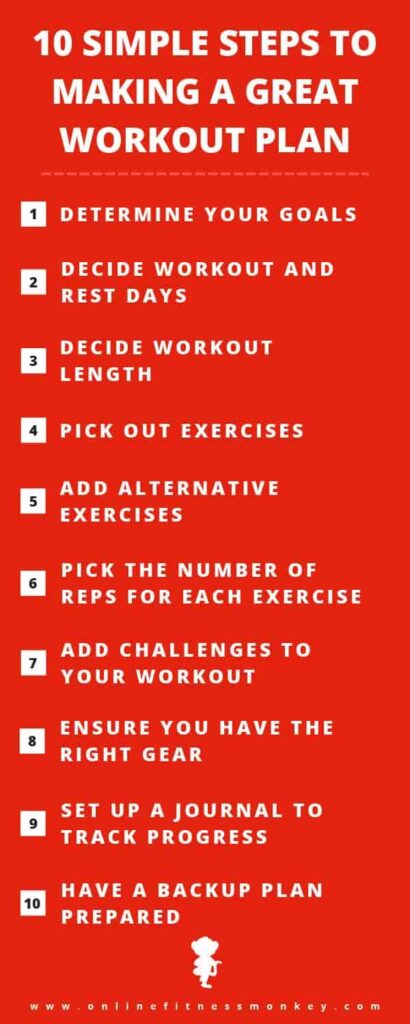Working out is a regularly scheduled activity or hobby for many people. However, if you are new to working out, you may not know where to start and decide to make a workout plan to stick to. But, what are some easy steps you can take to construct a top-notch workout plan?
There are 10 simple steps to making a great workout plan:
- Determine your goals
- Decide workout and rest days
- Decide workout length
- Pick out exercises
- Add alternative exercises
- Pick the number of reps for each exercise
- Add challenges to your workout
- Ensure you have the right gear
- Set up a journal to track progress
- Have a backup plan prepared
This article will detail what a workout plan is, explain how many days you should be working out to get the most benefit, and provide ten steps you can take to make your workout plan the best it can be for you.
Article Contents
What Is a Workout Plan?
A workout plan is essentially a personal plan that you can use to remind yourself to work out regularly and reach your fitness goals.
Making your own workout plan can help you save money on a trainer, and sticking to a plan that you made yourself will make it more likely that you will accomplish your health goals.
What Are the Benefits of a Workout Plan?
Other than the two benefits mentioned above of helping you stick to your workout and helping you save money on training, there are a variety of other benefits associated with making a workout plan; some include:
- It can help you achieve a balance in your life. When you are on a workout schedule, it becomes easier to track things like your food and water intake and sleep patterns. Plus, when you have a hold on these variables and regulate them properly, you will have a better chance of reaching your goals.
- It can help you break down your goals. When you have a concrete fitness plan, you can break down each goal you set into manageable bitesize parts. You also won’t lose track of what you are doing as long as you review and stick to your plan.
- It helps you avoid under or overtraining yourself. Because you have a proper plan for working out, you will not have to worry about burning out or participating in activities that will not help you reach your goals.
- It helps you set measurable goals and keep proper records. Creating a workout plan can be a goal in itself, and once you start on your plan, you will be motivated to finish it. You can also make a workout log to check things off as you go, which is another motivator. The log also allows you to share it with loved ones and memorize your workout.
How Many Days a Week Should You Work Out?
The number of days you need to spend working out depends on the goals you have in mind and the amount of experience you already have with fitness. For example, if you’ve never really worked out before, one day a week will likely be your body’s limit, whereas if you are used to hitting the gym 2 to 3 times a week, working out once a week will not help you.
If you want to improve your strength and get more lean and fit, plan to work out four to five days a week. You can, of course, make changes to your plan as needed according to your needs, such as limiting workout days.
If you are not used to working out, there are ways you can make it a habit. Even just getting up and moving around at a scheduled time each day without doing a planned workout will have you well on your way to being an exercise guru.
10 Simple Steps to Making a Great Workout Plan
There are many things you can do to make your workout plan the best it can be for you. The more detail and thought you put into your individualized schedule, the better it will work out for you and the more excited you will be about it.
The following are 10 of the best steps you can take when building your workout plan:
 Determine Your Workout Goals
Determine Your Workout Goals
Before constructing a workout plan, you should first understand your workout goals or what you would like them to be. Doing this will allow you to monitor your progress and reach your goals within your decided timeframe.
The first step you need to take is to determine how fit you are to make your goals more realistic and achievable. Once you know this, you can set your goals and adjust them as needed. Remember that persistence, patience, and time are necessary for success as well.
Set both short-term and long-term goals, as well as milestones, so that you can feel more confident on your path and have more motivation to continue your workouts.
Decide Your Workout Days and Rest Days
When drafting this part of your workout plan, you need to keep consistency in mind. To see results, you need to train often and over a long period. You need to design a routine so that you will enjoy working out and actually do it regularly.
The most doable workout plan is one that has the right ratio of workout days to rest days. The first step to doing this is to write down your schedule and decide which days work best for breaks and being active. Once you have this, decide the time of day or night you will exercise, put it in your calendar, and pledge to yourself that you will stick to this. If you need to, find an accountability partner.
You want to have two days for active recovery (light yoga, walking, light swimming), one official workout day, and one rest day. Active recovery helps you stay active and improves qualities like stamina that will help you in your workout.
Decide How Long You Want to Work Out For
As you create your workout schedule, you’ll also want to determine how long you want to work out for. How long should each session be so you can increase the likelihood of meeting your fitness goals while sticking to your day-to-day schedule?
Remember, no workout schedule is complete without a proper warm-up period before starting your routine, and cool down when it is over, so factor that in as you begin to set times.
Pick Out the Best Exercises for Your Goals
The best exercises for your goals are the ones that match the reason why you want to work out. For example, suppose you want to improve your general fitness. In that case, you will want to have a balance of strength, cardio, flexibility, and balance exercises, as well as proper nutrition and restoration added in. This essentially means you can choose any kind of exercise you like, as long as it fits one of these categories to help with your goals.
On the other hand, if you prefer to focus on strength and toning, you will want to do exercises like squats, deadlifts, chin-ups, and push-ups to help you build muscle and strength.
Add Varying Exercises
You must avoid too much repetition in your schedule to avoid burnout and reduce the chance of injury. Doing the same thing over and over will work the same muscles and joints, which will harm your ability to recover. So, you want to choose different activities that will work on your weaknesses and highlight your strengths.
Other benefits of varying your workout include:
- Help you get over a plateau in weight loss
- Build new muscles
- Prevent boredom and keep you mentally challenged
- Keeps exercise exciting
Pick Out the Number of Reps You Should Do
The number of reps you complete for each exercise depends on your goals. For example, if you want to work on muscular endurance, you will want to do 1-3 sets of 15-20 reps for each exercise, and for muscle size increases, 8-12 reps and 3-5 sets of each exercise. The last rep should also be the most difficult to challenge your body.
Add Challenges to Your Workout
This is essential for you to make gradual progress—whether it’s bringing up your speed on an exercise, the number of reps, or the volume on weights or other equipment. Challenging yourself is also a way to see if you’ve improved in fitness.
However, if you create a challenge before you are ready, you will increase the chances of injury and mess up your ability to recover. A general rule is to train four to six weeks at a certain difficulty level before increasing it, so make sure you plan for that as you develop your workout.
Of course, every person is different, and you should always listen to your body before implementing any changes you plan. Add difficulty to your workout over time in the way you feel is best for you; there is no one-size-fits-all workout.
Ensure You Have the Right Gear
As you plan out your workout regimen, you’ll want to keep in mind what you have at your disposal to assist workouts versus what requires you to go to the gym. Doing this will help you save money on a gym membership and be more resourceful with the things you have in your home.
For example, if you have some five-pound weights at home and want to build arm strength, use those instead of going to the gym to lift weights. If you don’t have the equipment you need for a certain exercise, then going to the gym is your best bet.
Gear also includes the clothes you wear when you work out. When you have good quality clothes to work out in, you will be more comfortable while you exercise, making it easier to complete your planned goals and reduce your risk of injury. Looking good and feeling confident will also increase your motivation.
Set Up a Journal to Track Progress
To make sure your plan is working, or to be able to make smart changes to your plan, you have to write down all things related to it. This includes hard data such as workout times, rep amounts, and mileage on various exercises and more subjective data such as how your body feels after a workout or how you are recovering from a completed workout.
Your thoughts and feelings are just as important when it comes to making a workout schedule. If your current plan is showing results, but you can’t mentally handle it, you are better off making a change instead of suffering through it for the sake of progress.
Have a Backup Plan Prepared
If you find yourself not reaching your goals or are unsatisfied with your progress after a month of being on your current plan, you may need to evaluate and restructure it. Also, if you are not having fun, the plan definitely needs to change. Working out should be an enjoyable and beneficial part of your routine, and the less fun it feels, the less motivated you will be.
Distractions and other things that will put you off of your workout plan are inevitable. Having a backup plan will help make sure that you can ease your way back on track and avoid feeling guilty for missing a few days of your plan. Life happens, and it’s okay if you mess up every once in a while.
Conclusion
Workout plans are a great personalized way to start your workout journey. Once you figure out how many days you should work out, there are plenty of other things you can do to make your plan a success, like making sure your plan is consistent and making changes to it if necessary. Whatever plan you design for yourself, you can achieve your fitness goals!




